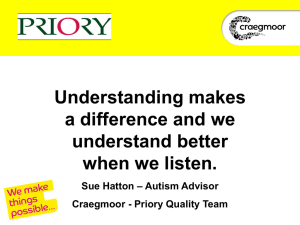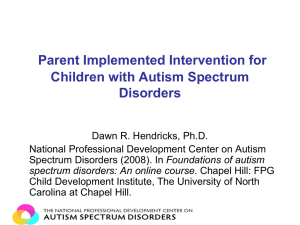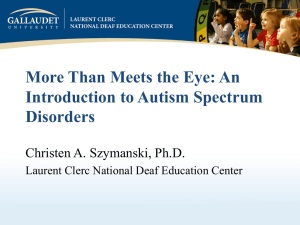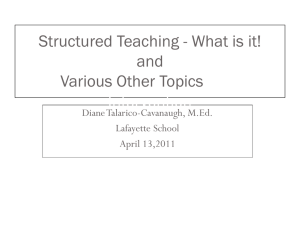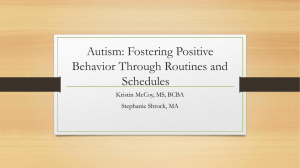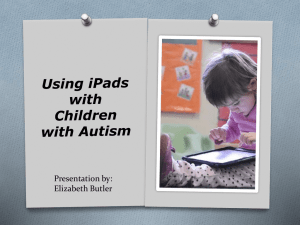STAR - Northwest PBIS Network
advertisement
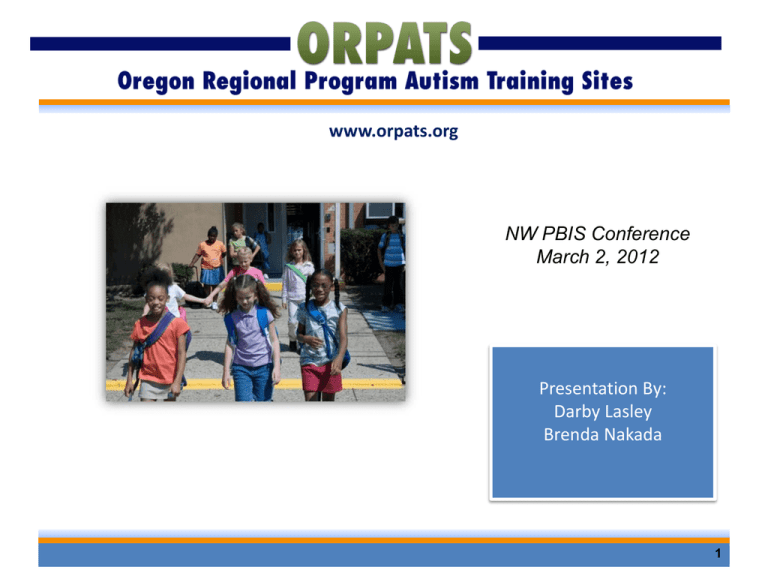
www.orpats.org NW PBIS Conference March 2, 2012 Presentation By: Darby Lasley Brenda Nakada 1 Presentation Topics What is ORPATS? What are the goals for 2011-2013? What is the Autism Teams component? What Instructional Strategies are training sites using? What about Parent Training? What does the Assessment Data Say? What is the Process to Access Training? 2 ORPATS: Oregon Regional Program Autism Training Sites Current ORPATS STAFF: • Joel Arick, Ph.D. • Jennie Willis, M.S. • Darby Lasley, M.S. • Brenda Nakada, M.S. • Karen Shepherd, M.S. John Gill, M.S Misten Daniels, M.S Middle School Pilot Sites (Social Skills Component) Consultants: • Phyllis Coyne, Kimberly Raines-Schmeltzer, Annette Skowron-Gooch Parent Training Project: • Anna Dvortckak ODE: • Nancy Latini, Julie York 3 What is the ORPATS Project? • ORPATS Staff are providing comprehensive workshops and extensive on-site “hands-on” training in research based instructional strategies to training site staff and autism specialists • ORPATS Training Sites model appropriate curriculum content using behavioral methods and provide training on these research based practices • Trained Autism Specialists provide hands-on training to other educators in their region at the training sites 4 5 ORPATS A Training Network Established 42 Oregon Regional Program Autism Training Sites (ORPATS) throughout the state. Training sites model research-based applied behavior analysis methods in addition to classroom curriculum Established a cadre of autism specialists to provide training to others at the ORPATS sites Maintained current sites and continue to develop new training sites throughout Oregon Collaborated with the Autism Teams Project to provide training to 25 Teams throughout Oregon Co-sponsored State-wide Conference on Educating Children with Autism in May of 2009 6 ORPATS Highlights: 2009-2011 500+ Teams attended an ORPATS workshop 200+ Teams have accessed an ORPATS site for “on-site, hands-on” training 350+ Students were in attendance at the ORPATS sites receiving services Since 2003 over 80% of the ORPATS sites established continue to train others 7 ORPATS GOALS: 2011-2013 Statewide Coordination of ORPATS Conduct Evaluation of ORPATS Outcomes and Student Progress Maintain & Develop ORPATS Training Sites Conduct Training Workshops Statewide Model Use of ORPATS Training Sites Build Capacity Beyond ORPATS Sites Support General Education Staff Expand the Autism Teams Component 8 Expand the Autism Teams Component Increase the statewide capacity of school districts and ESD teams to implement evidence based practices for students with ASD Provide training and the needed materials Reach 10 new educational teams Make the 2 day ORPATS workshop available to additional staff outside of the designated teams. Provide hands-on training to the 10 new teams Develop new teams at the Elementary, Middle/HS Levels Access the ORPATS training sites for support 9 Initial Trainings Three day “hands on” training workshop Support to assess students and develop programs Two days of follow up consultation in the classroom Observation of existing ORPATS sites Set Up Day Team members work together to develop student programs and schedules Curricula Provided Materials Such As: Complete STAR kit Training DVDs Data notebooks Visuals to support routines Token boards PECS Starter Kits Sunshine Literacy Kit FACTER Secondary Kit PRT starter kits Age appropriate materials for middle and HS students ORPATS Curricula and Research-Based Instructional Strategies Curriculum for EI/ECSE and Elementary Level Children Learning to communicate, understand language and social skills is the focus. Generalizing skills within functional routines at home and school is important. Developmental curriculum across all domains. Including: • • • • • • • • • STAR Autism Program (Strategies for Teaching based-on Autism Research, Arick, Loos, Falco and Krug, 2004) Parent training component at the EI/ECSE sites (Ingersoll and Dvortscak, Guilford Press, 2009) Inclusion and mainstreaming Peer tutoring and peer buddies PECS (Pyramid Educational Consultants, 2005) Augmentative Communication Systems Structured Teaching Incidental Teaching Commercial academic programs 14 Curriculum for Middle and High School Students Independence is key School and Community Routines become more of a focus Social Skill Development is also a priority Continue to use ABA strategies to teach specific skills needed for independence on routines Generalize skills within routines FACTER Program (Arick, Nave, Hoffman, 2004) Adjusting the Image Curriculum (WESD, Columbia Regional Program) 15 Essential Elements of Support Needed for Students with Autism Student schedule Each activity of the day identified for the student Activities of the class consistent with the schedule Pictures/words at students developmental level Staff schedule Staff is scheduled to support student as needed Direct instruction time is provided in order to implement curriculum Staff training Staff is trained to implement the student schedule Staff is trained in appropriate shaping/prompting/reinforcement techniques Staff is trained to implement the curriculum and adapt activities 16 Additional Elements of Support Classroom activities should be adapted to meet the students need A reinforcement system should be available as needed to motivate and reward student for appropriate behavior A curriculum appropriate for the student’s level should be implemented consistently 17 Research Indicates: Provide 1:1 intensive instruction in: • • • • • • Expressive language Receptive language Spontaneous Communication Pre-academics Play skills/Social Interaction and Pre-Teach Functional routines THEN Generalize the skills taught into the child’s school day and at home 18 Research Research Also Says that Effective Instructional Strategies to Teach this Content are the Applied Behavioral Analysis Strategies of: • Discrete Trial Training • Pivotal Response Training • Functional Routines Source: Simpson, R. Focus on Autism and Other Developmental Disabilities, Fall 2005 19 Video Examples Discrete Trial Training Level I: Labels of Objects Pivotal Response Training Level II: Commenting Functional Routines Level III: Transition 20 The STAR Program Strategies for Teaching based on Autism Research (Arick, Loos, Falco and Krug, 2004) Instructional methods of: • • • • Discrete Trial Training Pivotal Response Training Functional Routines Positive Behavior Interventions and Supports These strategies form the instructional base of this comprehensive program for children with autism. STAR Student Learning Profile: A Curriculum-based Assessment Shows the overall scope and sequence for the a research based Program Provide guidelines for determining which lesson to focus on for each student Shows instructional strategies that are most effective for lesson Shows which lessons can be taught simultaneously Establishes baseline and summarizes student’s instructional progression 22 Student Learning Profile (Levels 1,2,3) 23 PECS Picture Exchange Communication System (Frost and Bondy, 1994) PECS • Augmentative/alternative communication intervention package for individuals with autism spectrum disorder • Focuses on the initiation component of communication • Begins by teaching an individual to give a picture of a desired item to a “communicative partner", who immediately honors the exchange as a request. • The system goes on to teach discrimination of pictures and how to put them together in sentences. In the more advanced phases, individuals are taught to answer questions and to comment. Early Literacy Skill Builders (Attainment Company) Language-rich literacy curriculum for students with moderate to significant developmental disabilities, including autism. Systematic instruction to teach both print and phonemic awareness. Edmark Reading Program Uses a whole-word approach, with short instructional steps, consistent repetition, and positive reinforcement to ensure that students experience immediate success. Multiple learning modalities are incorporated Handwriting Without Tears http://www.hwtears.com/ Touch Math http://www.touchmath.com/ Structured TEACCH (University of North Carolina): Use of Independent Work Systems Visual Supports: Schedules Simple book schedule Simple wall schedule Written Schedule Visual Supports: Schedules Portable schedule Electronic Schedules Choice Wheel Parent Training Component Strategies based on: “Teaching Social Communication to Children with Autism” By Brooke Ingersoll and Anna Dvortcsak Published in 2010 Project ImPACT • Improving Parents As Communication Teachers • Encompasses the parent training curriculum Guiding Principles • Intervention is naturalistic (parents should be able to implement intervention within daily routines) • Typical development is used to guide selection of treatment strategies. • Children learn social communication through affectladen interactions with responsive caregivers. • Techniques are based on applied behavior analysis Parent Training Model View: Parents’ childrearing knowledge and specific skills can directly enhance their child’s development Goals: Provide systematic instruction in strategies to help parents accomplish specific goals or outcomes for their child Parent training is considered a primary intervention strategy Focus of Parent Training 1. Enhance parents’ skills in engaging their child in play and social interaction 2. Teach parents strategies to help their child acquire developmental skills 3. Help parents manage child’s behavior during ongoing daily routines Intervention Techniques Parents are taught techniques through: • • • • Written materials (Manual) Didactic presentation Video examples Group discussion of how techniques can be used during daily activities • Homework Roles in Parent Training Parent’s role: Primary intervention provider • Practice techniques • Implement intervention in the home/community Teacher’s role: Coach • Model Techniques • Provide Feedback Intervention Strategies Developmental Techniques (Interactive) • Increase engagement • Increase initiations • Provide the child the opportunity to initiate and respond without having to do so in a specific way Behavioral Techniques (Direct) • Teach specific skills Language, imitation or play Overview of Curriculum ORPATS Model Across Oregon State-wide Used in Early Childhood/Early Intervention Programs in all 8 regions of state Teams in each region present to parents 1-3 times each year (Groups range from 6-10 families) Most present in a group format to allow families to network together EI programs have also adapted to a home visit model Student Outcomes STUDENT ASSESSMENT RESULTS Preschool Project 17 month results 2009-2011 43 Pre-school Age Non-verbal Students: Initial Progress Results • Descriptive Study – 3 assessment periods • • • Initial assessment 9 month re-assessment 17 month re-assessment • Assessments • • • ASIEP-3 Peabody Picture Vocabulary Test (PPVT) Expressive Vocabulary Test (EVT-2) • All students are primarily non-verbal at initial assessment period • The data shown in this report • • Educational Assessment (subtest of ASIEP-3) Expressive Vocabulary Test (EVT-2) Students 28 students enrolled in the study • Students were new to the curriculum components • Students were primarily non-verbal • Students received 4 days a week of Early Childhood Special Education services at an ORPATS training site. • 11 students have data for the entire 17 month period (following slides report progress of these students). Educational Assessment Receptive Language 100 90 80 70 60 Rec. Lang 50 Rec. Lang 9 40 Rec. Lang 18 30 20 10 0 1 2 3 4 5 6 7 8 9 10 11 • Following 1 and 2 step commands • 91% of students made progress from initial assessment to 17 month assessment Expressive Language 80 70 60 50 Exp. Lang 40 Exp. Lang 9 Exp. Lang 18 30 20 10 0 1 2 3 4 5 6 7 8 9 • Using words to answer questions • 73% made progress 10 11 Body Concepts 120 100 80 Body 60 Body 9 Body 18 40 20 0 1 2 3 4 5 6 • Body Imitation • 82% made progress 7 8 9 10 11 Speech Imitation 100 90 80 70 60 Speech Im 50 Speech Im 9 40 Speech Im 18 30 20 10 0 1 2 3 4 5 6 7 • Imitating sounds and words • 100% made progress 8 9 10 11 Overall Scores 60 50 40 Raw Score 30 Raw Score 9 Raw Score 18 20 10 0 1 2 3 4 5 6 7 8 9 • Summary of all areas combined • 100% of students made progress 10 11 Expressive Vocabulary Test (EVT-2) Average Expressive Age Equivalent in Months 25 20 15 Series1 10 5 0 Initial 9 month 17 month • Initial assessment average score was 5.5 months • 9 month assessment average score was 10.5 months • 17 month assessment average score was 23.17 months • This represents 17.5 months of average progress in the 17 month period, or 1 month of language gain for each month of instruction How To Obtain Training For Your District Access ORPATS training by contacting your Regional Autism Coordinator Release funds are available for ORPATS training activities. Workshops are offered through the ORPATS grant. All districts are welcome to the workshops. Workshops are scheduled throughout the year as needed. The training schedule is updated regularly and information is available on the ORPATS website. Autism Teams Component is on-going throughout the 2011-13 school years. Contact your Regional Autism Coordinator if interested in participating. www.orpats.org 52


